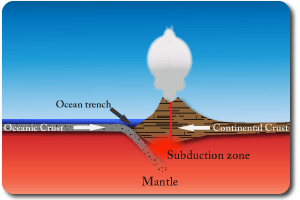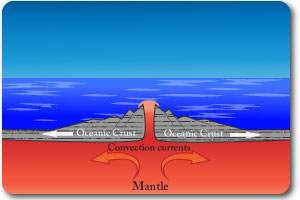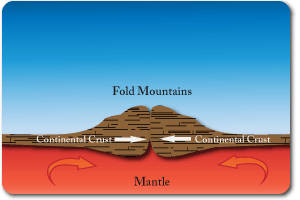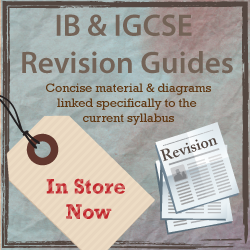
Biodiversity: The amount of biological or living diversity per unit area. It includes the
concepts of species diversity, habitat diversity and genetic diversity.
Genetic diversity: the genetic range that is present in a population of a species. Species that have a small genetic diversity are more at risk of being wiped out by diseases. Selective breeding by humans to domesticate animals or grow plants with specific traits has reduced the gene pool in many species.
Species diversity: the range of species living in a specified area. An area may have a high density of wildlife, but if they are all from a few different species then it would have a low species diversity.
Habitat diversity: the range of different habitats in an ecosystem. Jungle or forest ecosystems are likely to have a higher habitat diversity than desert or tundra ecosystems.
Tectonic Plates
The earths crust is split into sections called tectonic plates. Convection currents in the mantle (the molten layer under the crust) drag these plates slowly in different directions. In some places the edges of the plates crash into each other (destructive and collision boundaries) and in other places the plates edges move apart (constructive boundaries).
Plate tectonics have created the major mountain ranges of the world and their movement has changed the locations of landmasses and some of the links between landmasses. This has had a significant impact on species diversity:
- Mountain ranges form a physical barrier that many species do not cross, this allows isolation of gene pools and subsequently uniques species of plants and animals living on the same land masses.
- Plate seperation such as the African and South American plates moving apart also allow isolation of gene pools. The movement of land masses has also meant that many continents have travelled through different climate zones (over millions of years) which has led to species adaptation and evolution.
Destructive Boundary
- Oceanic & continental plates collide. The oceanic plate is denser and so sinks under the continental plate.
- As the oceanic plate sinks it takes some sand, water and other material from the sea bed with it. This melts and is gaseous which causes it to force its way up to the surface as a volcano.
- The continental plate crumples at the edge creating fold mountains such as the Andes in addition to the volcanoes.
- New Islands may be formed such as Surtsey which then become populated and allow isolated evoltution of species.

Constructive Boundary
- Convection currents in the mantle drag the plates apart.
- Magma rises to fill the gap and solidifies to form new crust.
- As the process repeats a ridge is formed and this slowly gets wider as the plates continue to seperate.
- Example: the Mid-Atlantic Ridge.
- This creates fissure volcanoes which are long cracks, they are less explosive.
- The Rift Valley running through East Africa is another example. It is home to some of the worlds deepest freshwater lakes.

Collision Boundary
- Convection currents in the mantle pull two plates of continental crust together.
- Since both crusts are made of the same material and have equal density neither subducts. They crumple up.
- This process creates fold mountains. There are no volcanoes at these boundaries but earthquakes occur. Rising land at new altitudes generates new habitats.
- Example: the Himalayas created by the Eurasion and India plates colliding..




